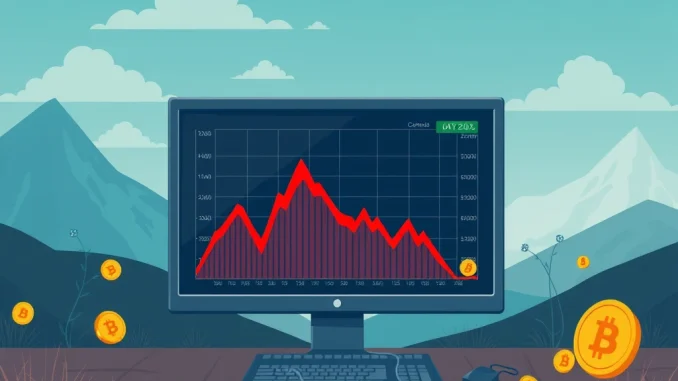
The world of high-stakes cryptocurrency trading just delivered a harsh lesson, highlighting the extreme volatility that can impact even seasoned players. In a dramatic turn of events, James Wynn, a prominent trader often referred to as a Hyperliquid whale, reportedly suffered a massive financial blow. This incident serves as a stark reminder of the risks inherent in leveraged positions on platforms like a decentralized exchange.
The Hyperliquid Whale’s Costly Trade
According to reports from on-chain analysts, including @EmberCN, James Wynn held a substantial long position on Bitcoin (BTC) on the Hyperliquid platform. As a recognized ‘whale,’ Wynn’s trades are typically large enough to potentially influence market movements, making his outcomes particularly noteworthy. However, recent market turbulence proved challenging even for a trader of his size.
The specific trigger for the market downturn that impacted Wynn’s position is cited as a public disagreement between high-profile figures, U.S. President Donald Trump and Tesla CEO Elon Musk. While the direct link between this spat and the BTC price movement can be debated, the market reacted, causing a drop that had significant consequences for leveraged traders.
What Led to the Crypto Liquidation?
When the price of an asset like Bitcoin falls significantly while a trader holds a leveraged ‘long’ position (betting on the price going up), their position can be automatically closed by the exchange to prevent further losses exceeding their margin. This process is known as crypto liquidation. In Wynn’s case, the Bitcoin price dip triggered the forced sale of a massive 379 BTC from his long position.
After this initial, forced liquidation, Wynn reportedly chose to manually close the remaining portion of his holdings. This sequence of events underscores the speed and finality with which leveraged positions can unravel during periods of high volatility.
Understanding the $2.9M Bitcoin Loss
The financial impact on James Wynn was substantial. His leveraged position was backed by $3.6 million in USDC margin. The forced sale and subsequent manual closure resulted in a staggering Bitcoin loss amounting to $2.9 million. This left him with only $700,000 of his initial margin. It’s worth noting that he also received approximately $225,000 in support from followers online after appealing for assistance, slightly cushioning the blow but still representing a significant overall loss.
This recent event is particularly sharp considering Wynn’s past performance. Reports indicate that he was once up by as much as $87 million. However, over a mere two weeks, his fortunes reversed dramatically, culminating in a reported overall loss of $20.5 million. With his capital significantly depleted, making large-scale trades, typical of a Hyperliquid whale, becomes considerably more difficult.
Trading on a Decentralized Exchange Like Hyperliquid
Hyperliquid is a perpetual futures decentralized exchange (DEX). Unlike centralized exchanges, DEXs operate without a central authority, often relying on smart contracts and automated market makers. While they offer benefits like self-custody and potentially greater transparency for on-chain activity (as demonstrated by the analyst tracking Wynn’s trades), trading on them, especially with leverage, carries the same fundamental risks as on centralized platforms. The speed of execution and the unforgiving nature of liquidation mechanisms are universal in high-leverage trading environments.
Lessons from the Liquidation
James Wynn’s experience serves as a cautionary tale for anyone involved in leveraged crypto trading:
- Volatility is Unpredictable: External events, even seemingly unrelated ones, can impact market sentiment and trigger rapid price swings.
- Leverage Amplifies Risk: While leverage can magnify gains, it equally magnifies losses, leading to quick liquidation when the market moves against a position.
- Whales Aren’t Immune: Even large, experienced traders face significant risks and can suffer devastating losses.
- On-Chain Transparency: For DEXs, trading activity is often public, allowing analysts to track large positions and liquidations.
Conclusion: A Stark Reminder for Crypto Traders
The significant Bitcoin loss suffered by James Wynn on the Hyperliquid decentralized exchange after a swift market downturn resulting in a major crypto liquidation is a powerful illustration of the inherent volatility and risks in leveraged trading. While the potential rewards in crypto can be high, the potential for rapid and substantial losses, even for a Hyperliquid whale, is a reality that all participants must acknowledge and prepare for. This event underscores the importance of risk management and understanding the unforgiving mechanics of leverage and liquidation.



